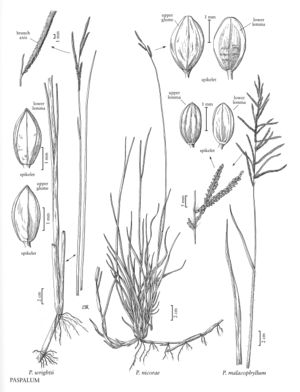Difference between revisions of "Paspalum malacophyllum"
FNA>Volume Importer |
imported>Volume Importer |
||
| (3 intermediate revisions by 2 users not shown) | |||
| Line 4: | Line 4: | ||
|publications= | |publications= | ||
|common_names=Ribbed paspalum | |common_names=Ribbed paspalum | ||
| + | |special_status={{Treatment/ID/Special_status | ||
| + | |code=I | ||
| + | |label=Introduced | ||
| + | }} | ||
|basionyms= | |basionyms= | ||
|synonyms= | |synonyms= | ||
| Line 38: | Line 42: | ||
|publication title= | |publication title= | ||
|publication year= | |publication year= | ||
| − | |special status= | + | |special status=Introduced |
| − | |source xml=https:// | + | |source xml=https://bitbucket.org/aafc-mbb/fna-data-curation/src/200273ad09963decb8fc72550212de541d86569d/coarse_grained_fna_xml/V25/V25_1467.xml |
|subfamily=Poaceae subfam. Panicoideae | |subfamily=Poaceae subfam. Panicoideae | ||
|tribe=Poaceae tribe Paniceae | |tribe=Poaceae tribe Paniceae | ||
Latest revision as of 17:57, 11 May 2021
Plants perennial; cespitose, sometimes with short rhizomes. Culms 90-200 cm, erect; nodes sunken, glabrous or pubescent, brown. Sheaths pubescent; ligules 4-5 mm, membranous, brown, acute; blades 12-40 cm long, 8-35 mm wide, flat or conduplicate, pubescent below, glabrous above, distinctly pubescent basally. Panicles terminal, with 8-25 racemosely arranged branches; branches 1-8 cm, divergent to erect; branch axes 1-1.2 mm wide, margins scabrous, terminating in a spikelet; pedicels 0.2-0.4 and 0.5-1.2 mm long, flattened, scabrous. Spikelets 1.8-2 mm, paired, appressed to or divergent from the branch axes, oblong-elliptic, white to stramineous. Glumes absent; lower lemmas glabrous, ribbed over the veins, sulcate between, 5-veined, margins entire; upper lemmas as long as the lower ones, longitudinally papillose-striate, glabrous, pale-colored. Upper florets white to stramineous. 2n = 40, 60.
Distribution
Fla., Ga., Tex.
Discussion
Paspalum malacophyllum is native from Mexico to Bolivia and Argentina. It was introduced to the southern United States for forage and soil conservation, and is now established in the southeastern United States, growing in disturbed sites at scattered locations.
Selected References
None.
